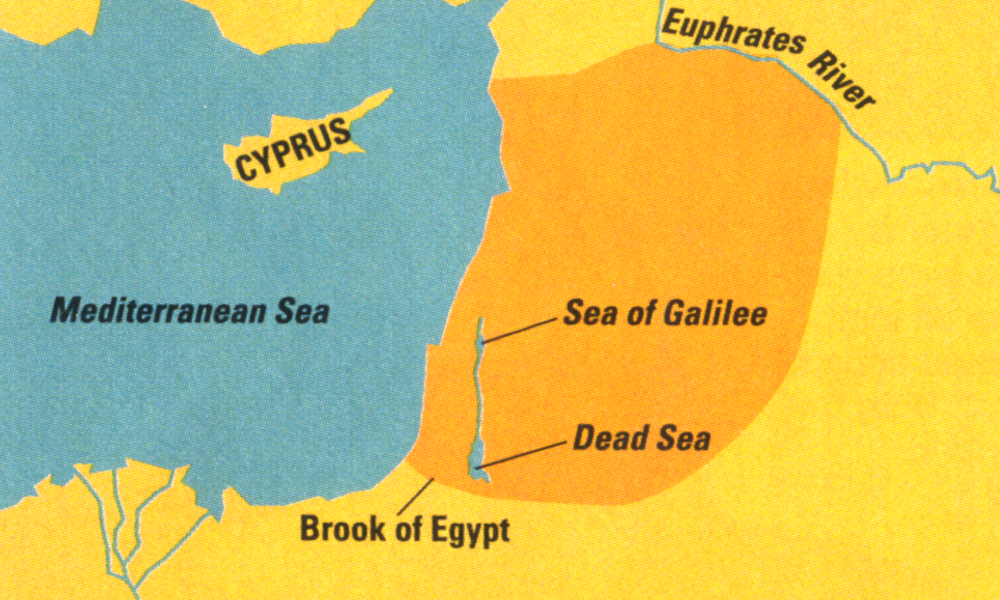The following article is a 1996 piece by biblical scholar Jacob Milgrom in which he describes the various territorial definitions of Eretz Yisrael, or “Land of Israel,” in the bible. With the ascendance of religious nationalist elements in the Israeli government, understanding the concept of Eretz Yisrael is increasingly essential in understanding Israeli political rhetoric and Israeli society writ large. However, Eretz Yisrael is a relatively nebulous term, denoting a vague geographic area while invoked to justify specific territorial claims. Milgrom does an excellent job in elucidating what constitutes the Land of Israel in the bible through biblical citation and with a series of helpful maps. Hopefully this article will provide a comprehensive and illustrative explanation of one of the most important and controversial concepts in modern Israel.
To see this article in its original context, click here.
Now that Binyamin Netanyahu will be leading the peace negotiations backed by a parliamentary coalition that includes religious and ultrareligious parties, it is more important than ever to consider right-wing claims based on the “whole land of Israel,” or Eretz Yisrael Hashlemah. It is not so clear as might be imagined.
The concept is ostensibly derived from the Bible. The fact is, however, that there is in the Bible no single delineation of “the whole land of Israel.” The Torah describes three different sets of boundaries for the land of Israel; Prophets describes three more; and the rabbinic authorities contributed a seventh.
- In Genesis 15:18, which defines the land during the age of the Patriarchs, Israel extends from the Brook of Egypt (thought to be the Wadi el-Arish, just south of the Gaza strip) to the Euphrates.

- According to Numbers 34, the territory assigned to the 12 tribes extends from the Jordan River to the Mediterranean Sea and from Lebo- Hamath in the north (Lebo, in what is now Lebanon) to Kadesh-Bamea in the south (just below Beer-Sheba).

- In Deuteronomy 2:24-3:17, Jordan is conquered and its territory is added to that of the 12 tribes.

- The territory after the conquest of Canaan (Joshua 1 to Judges 3) comprises three subdivisions: (a) land neither allotted nor conquered,i.e., Lebanon; (b) land allotted but not conquered, i.e., the coastal strip (Joshua 13:2-4), the Jezreel Valley (Joshua 17:ll-12;Judges 1:27), most of Dan (Joshua 19:47; Judges 1:34-35, 18:l-2), Jerusalem, Gezer, and other cities (Joshua 15:63, 16:10; Judges 1:21, 29-33); (c) land allotted and conquered, i.e., the rest of the land designated in no. 2.

- Judges 20:1 and Kings 5:3. describe the settled lands, i.e., from Dan to Beer-Sheba.

- The imperial map of David and Solomon includes territory outside the ethnic and ideal land of Israel, such as Edom, Moab, Ammon , and Aram, but not Lebanon (2 Samuel:8, 10-11).

- The rabbinic map, as described in Mishnah Shevi’it 6.1 and Mishnah Hallah 4:8, extends from Kezib (north of Acco) to Kadesh-Bamea.

These seven maps make it clear that the borders of both the real (that is, occupied) land of Israel and the ideal land of Israel were constantly changing to fit historical circumstances. Maps 1,2, and 3 include Lebanon, for example, but Lebanon is missing in nos. 4 and 6. In no. 4, Joshua neither conquers Lebanon nor assigns it as a tribal inheritance and no. 6 does not even include Lebanon as a national legacy. On the contrary, both David and Solomon abandon the Phoenician coast and sign a parity treaty with Hiram, King of Tyre (1 Kings 5:15), even ceding to him tribal territory in the Galilee (1 Kings 9:11-13).
The rabbinic authorities were fully aware of these shifting borders. They resolved the discrepancies by refer- ring to the principle of ki yarhiv, that is, the phrase in the Bible that says, “When the Lord enlarges your territory” (Deuteronomy 12:20). In other words, they relegated the unoccupied territories to messianic times.
On one point, however, the maps all agree. The southern boundary has never changed. This boundary begins at Wadi el-Arish (just south of the Gaza Strip), passes by Kadesh-Barnea, and terminates at the Dead Sea (Numbers 34:3-5; Joshua 15:2-4). As a result, the southern half of Israel—including the entire Negev, Arava, and Eilat—is not part of the Promised Land.
Recognizing the agreed-upon southern boundary in all the maps, the rabbis exempted the agricultural yield of the sabbatical year in the southern territories from the prohibition mandated by the laws of shevi’it Produce from the Arava, Israel’s main source of winter crops, could be eaten even when it was forbidden to harvest crops in the Land of Israel.
In short, “the whole land of Israel” is a varying composite of territories delineated by realities on the ground and messianic dreams. It cannot be used to guide today’s peace negotiations, unless Israelis are likewise prepared to yield the Negev.

